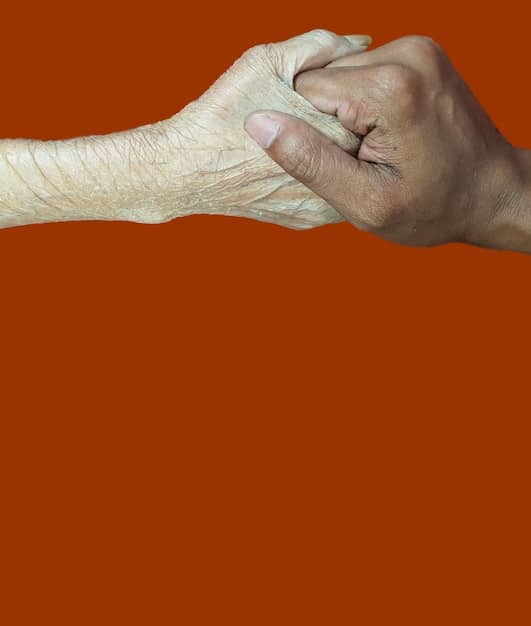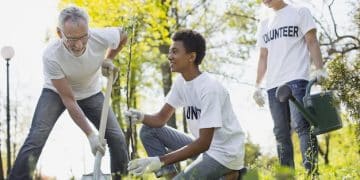Bridging the Gap: How to Unite Generations in Social Justice Activism

Bridging the generational gap in social justice activism involves fostering mutual understanding, valuing diverse experiences, and creating inclusive spaces where everyone can contribute their unique skills and perspectives to drive meaningful change.
The fight for social justice is a continuous journey, one that requires the energy, wisdom, and dedication of people from all walks of life. But how can we effectively bridge the generational gap in social justice activism to create a united front for change?
Understanding the Generational Landscape in Social Justice
Each generation brings unique experiences, perspectives, and approaches to social justice activism. Understanding these differences is the first step toward bridging the gap and creating a more inclusive movement.
The Silent Generation and Baby Boomers:
Having lived through significant historical events, they often bring a wealth of experience and a deep understanding of systemic issues. Their activism is often rooted in traditional methods and a strong sense of civic duty.
Generation X:
Known for their independence and pragmatism, Gen Xers tend to be adaptable and resourceful. They often seek practical solutions and may be skeptical of idealism.

Millennials and Generation Z:
Digital natives, Millennials and Gen Z bring technological savvy and a strong emphasis on inclusivity and intersectionality. They are often passionate about online activism and leveraging social media for change.
- Silent Generation and Baby Boomers: Deep understanding of historical context.
- Generation X:Resourceful and focused on practical solutions.
- Millennials and Generation Z:Digital activism and inclusivity.
- All generations: Shared desire for a just and equitable world.
By recognizing and appreciating the strengths that each generation brings to the table, we can foster a more collaborative and effective approach to social justice activism.
Valuing Diverse Experiences and Perspectives
One of the key aspects of bridging the generational gap is to actively value the diverse experiences and perspectives that each generation offers. This requires creating spaces where individuals feel heard, respected, and understood.
Active Listening:
Encourage active listening and dialogue between generations. This involves creating opportunities for individuals to share their stories, perspectives, and insights without judgment.
Mentorship Programs:
Develop mentorship programs that pair younger activists with older mentors. This allows for the transfer of knowledge, skills, and experience across generations.
Intergenerational Workshops:
Organize intergenerational workshops where individuals can come together to discuss social justice issues, share their perspectives, and collaborate on solutions.

- Create Safe Spaces: Where open and honest communication is encouraged.
- Promote Empathy: By understanding different life experiences.
- Value Different Perspectives: To broaden understanding of complex issues.
- Encourage Collaboration: For innovative and effective solutions.
Valuing diverse experiences and perspectives enriches the activist movement and leads to more comprehensive and inclusive solutions.
Leveraging Technology for Intergenerational Collaboration
Technology can be a powerful tool for bridging the generational gap in social justice activism. By leveraging digital platforms and tools, we can facilitate communication, collaboration, and knowledge sharing across generations.
Social Media Platforms:
Utilize social media platforms to connect activists from different generations. Create online communities where individuals can share information, discuss issues, and coordinate actions.
Online Collaboration Tools:
Explore online collaboration tools such as shared documents, project management software, and video conferencing platforms to facilitate remote collaboration and knowledge sharing.
Digital Literacy Training:
Provide digital literacy training to older activists who may not be as familiar with technology. This will empower them to participate more fully in online activism and collaboration efforts.
- Virtual Mentorship Programs:Connect experienced activists with younger ones online.
- Digital Storytelling Projects:Share personal stories through digital media.
- Online Forums:Discuss social justice issues and coordinate actions.
- Tech Training Workshops:Empower older activists with digital skills.
By embracing technology, we can harness the collective wisdom and expertise of activists from all generations.
Addressing Generational Differences in Communication Styles
Generational differences in communication styles can sometimes create barriers to effective collaboration. Being aware of these differences and adapting our communication approaches can help bridge the gap and foster stronger relationships.
Direct vs. Indirect Communication:
Some generations may prefer direct and concise communication, while others may favor a more indirect and nuanced approach. Be mindful of these preferences and adapt your style accordingly.
Formal vs. Informal Language:
Different generations may have different preferences for formal versus informal language. Use language that is inclusive and respectful of all individuals.
Digital vs. Face-to-Face Communication:
While younger generations are often comfortable communicating digitally, older generations may prefer face-to-face interactions. Strive to find a balance between digital and in-person communication to accommodate everyone’s preferences.
- Clear and Concise Messaging:Ensure messages are easily understood.
- Respectful Language:Use inclusive and considerate language.
- Diverse Communication Channels:Offer options for everyone.
- Patience and Understanding:Be tolerant of different styles.
By adapting our communication styles, we can create a more inclusive and collaborative environment for activists of all ages.
Creating Inclusive Spaces for All Generations
Creating inclusive spaces is essential for fostering intergenerational collaboration in social justice activism. These spaces should be welcoming, accessible, and respectful of all individuals, regardless of age, background, or experience.
Accessibility Considerations:
Ensure that physical spaces are accessible to individuals with disabilities. Provide accommodations such as ramps, elevators, and accessible restrooms.
Inclusive Language:
Use inclusive language that is respectful of all individuals. Avoid using jargon or slang that may not be understood by everyone.
Cultural Sensitivity:
Be mindful of cultural differences and sensitivities. Educate yourself about different cultural norms and practices to avoid unintentional offense.
- Welcoming Environment:Make everyone feel valued and respected.
- Diverse Representation:Ensure diverse voices are heard.
- Open Dialogue:Encourage open and honest communication.
- Respectful Listening:Value different perspectives.
By creating inclusive spaces, we can foster a sense of belonging and empower activists from all generations to contribute their unique talents and perspectives.
Recognizing and Celebrating Intergenerational Successes
Recognizing and celebrating intergenerational successes is important for reinforcing positive collaboration and inspiring future joint efforts. Highlighting the achievements of intergenerational teams can motivate others to embrace collaboration and bridge the generational gap.
Share Success Stories:
Share stories of successful intergenerational collaborations through newsletters, social media, and other communication channels. Highlight the positive outcomes and lessons learned from these experiences.
Award Programs:
Establish award programs that recognize and celebrate outstanding intergenerational collaborations in social justice activism. This can help raise awareness of the importance of bridging the generational gap and inspire others to get involved.
Public Recognition:
Publicly acknowledge the contributions of intergenerational teams at events, conferences, and other gatherings. This can help increase visibility and recognition for the work being done.
- Highlight Collaborative Achievements:Share positive outcomes and impact.
- Acknowledge Individual Contributions:Recognize the value of each member.
- Celebrate Milestones:Mark successes and reaffirm commitment.
- Promote Intergenerational Partnerships:Encourage future collaborations.
By highlighting and celebrating intergenerational successes, we can demonstrate the power of collaboration and inspire others to bridge the generational gap in social justice activism.
| Key Point | Brief Description |
|---|---|
| 🤝 Understanding Differences | Acknowledge unique perspectives each generation brings. |
| 📱 Leveraging Technology | Use digital platforms for communication and collaboration. |
| 🗣️ Communication Styles | Adapt to generational communication preferences. |
| 🎉 Celebrating Successes | Recognize and share achievements of intergenerational teams. |
FAQ
▼
Bridging the gap allows for diverse perspectives and skill sets, enhancing the effectiveness of social justice efforts. It ensures that movements are inclusive and representative, fostering stronger community support.
▼
Participating in digital literacy training, seeking mentorship from younger activists, and utilizing user-friendly platforms can help. Embracing technology expands their reach and modernizes their activism.
▼
Younger generations often excel in social media strategies, online organizing, and digital communication. Their tech-savviness helps amplify messages, mobilize support, and create impactful online campaigns.
▼
Active listening, respectful dialogue, and adapting communication styles are crucial. Understanding generational preferences for communication can foster stronger relationships and avoid misunderstandings.
▼
Mentorship programs facilitate knowledge transfer and skill development between generations. They provide a structured way for younger and older activists to learn from each other’s experiences and insights.
Conclusion
Bridging the generational gap in social justice activism is not only beneficial but essential for creating effective and sustainable change. By valuing diverse perspectives, leveraging technology, and fostering inclusive spaces, we can unite generations and build a stronger, more equitable world for all.





